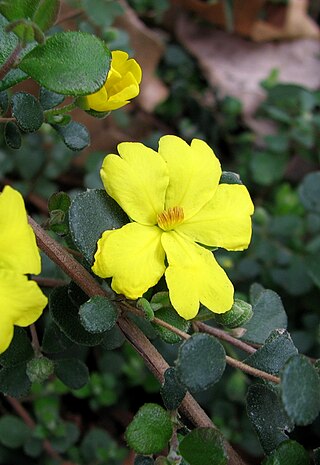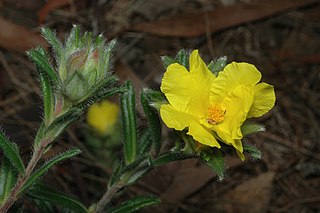
Hibbertia sericea, commonly known as silky guinea-flower, is a species of flowering plant in the family Dilleniaceae and is endemic to south-eastern Australia. It is an erect or spreading shrub with softly-hairy branches, elliptic to egg-shaped leaves with the narrower end towards the base, and yellow flowers with eight to fourteen stamens in a cluster on one side of two hairy carpels.

Hibbertia truncata, commonly known as Port Campbell guinea-flower, is a species of flowering plant in the family Dilleniaceae and is endemic to Victoria in Australia. It is a prostrate to low-lying shrub with hairy foliage, broadly egg-shaped leaves with the narrower end towards the base, and yellow flowers with ten to twelve stamens joined in a single cluster on one side of two hairy carpels.
Hibbertia appressa, commonly known as trailing guinea flower, is a species of flowering plant in the family Dilleniaceae and is endemic to south-eastern Australia. It is a low-lying or scrambling shrub with lance-shaped to egg-shaped leaves and yellow flowers with nine to twelve stamens arranged in a single group.
Hibbertia brennanii is a species of flowering plant in the family Dilleniaceae and is endemic to the Arnhem Land escarpment. It is a low, spreading sub-shrub with hairy foliage, elliptic to lance-shaped leaves and pale yellow flowers arranged singly in leaf axils, with ten to twelve stamens arranged in groups around the two carpels.
Hibbertia brevipedunculata is a species of flowering plant in the family Dilleniaceae and is endemic to northern Australia. It is a sub-shrub with hairy foliage, linear to lance-shaped leaves with the narrow end towards the base, and yellow flowers arranged singly on the ends of branches or short side shoots, with thirty to forty-four stamens arranged in bundles around the two carpels.
Hibbertia devitata is a species of flowering plant in the family Dilleniaceae and is endemic to south-eastern continental Australia. It is an erect to spreading shrub with linear to lance-shaped leaves and single yellow flowers arranged on the ends of branchlets, usually with six to eight stamens joined in a single group on one side of two carpels.
Hibbertia hirta is a species of flowering plant in the family Dilleniaceae and is endemic to the Budawang Range in New South Wales. It is a shrub with hairy foliage, narrow elliptic to narrow lance-shaped leaves, and yellow flowers with eleven or twelve stamens arranged in a cluster on one side of the two carpels.
Hibbertia nemorosa is a species of flowering plant in the family Dilleniaceae and is endemic to north Queensland. It is a shrub with ridged branches, oblong leaves and yellow flowers arranged singly or in pairs in leaf axils with 40 to 48 stamens and up to eight staminodes arranged around two or three carpels.
Hibbertia pallidiflora is a species of flowering plant in the family Dilleniaceae and is endemic to south-eastern continental Australia. It is usually a small, dense shrub with hairy branches, egg-shaped to lance-shaped leaves with the narrower end towards the base, and cream-coloured to pale yellow flowers with eight to thirteen stamens joined at the base on one side of two carpels.

Hibbertia platyphylla is a species of flowering plant in the family Dilleniaceae and is endemic to south-eastern South Australia. It is a shrub with linear stem leaves and yellow flowers arranged singly in leaf axils with ten to fifteen stamens arranged on one side of two carpels.

Hibbertia praemorsa is a species of flowering plant in the family Dilleniaceae and is endemic to southern New South Wales. It is a shrub with hairy foliage, oblong leaves and yellow flowers arranged singly on the ends of branches with seven to nine stamens on one side of two carpels.

Hibbertia puberula is a species of flowering plant in the family Dilleniaceae and is endemic to New South Wales. It is a small shrub with softly-hairy foliage, narrow egg-shaped to almost linear leaves, and yellow flowers usually arranged singly short side shoots with ten to fourteen stamens on one side of two carpels.
Hibbertia reticulata is a species of flowering plant in the family Dilleniaceae and is endemic to north Queensland. It is a shrub with spreading branches, egg-shaped leaves with the narrower end towards the base, and yellow flowers arranged singly in leaf axils, with 32 to 48 stamens arranged in two or three groups around the two densely hairy carpels.

Hibbertia rhynchocalyx is a species of flowering plant in the family Dilleniaceae and is endemic to the Gibraltar Range National Park in eastern Australia. It is a low shrub with hairy foliage, oblong leaves and yellow flowers with twelve stamens joined at the base on one side of two hairy carpels.
Hibbertia rufociliata is a species of flowering plant in the family Dilleniaceae and is endemic to a restricted area of north Queensland. It is a shrub with hairy foliage, elliptic to lance-shaped leaves with the narrower end towards the base, and yellow flowers usually arranged singly in leaf axils with 36 to 44 stamens arranged in bundles around two densely scaly carpels.
Hibbertia samaria is a species of flowering plant in the family Dilleniaceae and is endemic to Victoria, Australia. It is a small, low-lying or mat-forming shrub with hairy foliage, linear leaves and yellow flowers with ten to fifteen stamens arranged around three hairy carpels.
Hibbertia scabrifolia is a species of flowering plant in the family Dilleniaceae and is endemic to the Northern Kimberley region of Western Australia. It is a shrub with low-lying branches, linear leaves and yellow flowers usually arranged singly near the ends of branches, usually with 20 to 22 stamens arranged in bundles around two densely scaly carpels.
Hibbertia sessiliflora is a species of flowering plant in the family Dilleniaceae and is endemic to south-eastern continental Australia. It is a small, sparsely hairy shrub with thin, low-lying branches, elliptic to lance-shaped leaves and yellow flowers with four to six stamens in a single cluster on one side of two hairy carpels.

Hibbertia superans is a species of flowering plant in the family Dilleniaceae and is endemic to New South Wales. It is a low, spreading shrub with silky-hairy foliage, linear leaves and yellow flowers with six to nine stamens on one side of two carpels.
Hibbertia tenuifolia, commonly known as narrow-leaved guinea flower, is a species of flowering plant in the family Dilleniaceae and is endemic to eastern Australia. It is a small, spreading shrublet with hairy foliage, linear leaves and yellow flowers with twelve to sixteen stamens on one side of two carpels.






